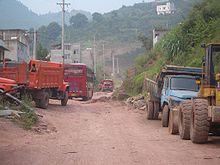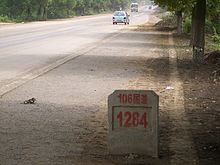- China National Highways
-
The China National Highways (simplified Chinese: 国道; traditional Chinese: 國道; pinyin: Guódào; literally "national road") are a series of trunk roads throughout all of mainland China. Although they are called highways (such as the Jingbao Highway), they are not necessarily expressways. However, like expressways, a toll is sometimes charged.
Contents
Regulation
Although an accepted speed limit on China National Highways is 100 km/h, it is not uncommon to see cars pass other by in well in excess of 100 km/h. The lack of speed detection cameras on some routes, lack of a posted speed limit outside of localities and tremendous distances of road mileage, means that enforcing this speed limit is rather herculean. In addition there is a notable shortage of traffic police in mainland China.
Nationwide highways often begin with the letter G, followed by three numerals, e.g.: G107. It is said that the G stands for 国家 (guójiā), or national.[1]
The numbering of the highways is as follows:
- Five vertical and seven horizontal main routes are labelled in the 000 series (the so called "five downs and seven acrosses").
- Except for China National Highway 112, which originates in Tianjin, all highways in the 100 series (e.g. 102, 106) begin from Beijing, the capital city of the People's Republic of China, and spread out in all compass directions;
- Highways in the 200 series stretch from north to south;
- Highways in the 300 series stretch from west to east (e.g., from Lhasa in Tibet through to Dandong in Liaoning province).
Highway construction
The building of highways is seen as key to accelerating infrastructure construction. In 2003, completed investment in highway construction was 350 billion yuan and 219 key highway projects progressed, focusing mainly on the five north-south and seven east-west national arterial highways as well as highways in western China and in rural areas. By the end of 2004, the total length of highways open to traffic reached 1.871 million km, including 34,300 km (21,300 mi) of expressways up to advanced modern transportation standard, ranking second in the world. The nation's highway density has now reached 19.5 km per 100 km2.
With the completion in 2008 of the five north-south and the seven east-west national arterial highways, totaling 35,000 km (22,000 mi), Beijing and Shanghai will be linked by major highways, chiefly expressways, to the capitals of all provinces and autonomous regions of China, creating highway connections between over 200 cities.
The aim of the National Expressway Network Plan approved in early 2005 is an expressway system connecting all capitals of provinces and autonomous regions with Beijing and with each other, linking major cities and important counties. The network will have a total length of about 85,000 km (53,000 mi), including seven originating in Beijing; the Beijing-Shanghai, Beijing-Taipei, Beijing-Hong Kong-Macau, Beijing-Kunming, Beijing-Lhasa, Beijing-Ürümqi, and Beijing-Harbin expressways. Half of the projects are already underway.
List of all China National Highways
Former 000 Series
Note: 000 Series China National Highways pointed to five specific vertical routes, as well as seven specific horizontal routes. Routes ending in "0" were north-south (vertical) routes; routes ending in "5" were east-west (horizontal) routes.
Note: The new system with two to four numbers that indicate the "NTHS"(7918) system is now in use instead of the 000 Series.
For the expressways' new numbering system, Expressways of China.
Original 000 Series numbers:
- China National Highway 010: Tongjiang (Heilongjiang) - Sanya (Hainan), 5,700 km (3,500 mi)– the longest China National Highway overall, (aka Tongsan Expressway) - now G11 and part of G15
- China National Highway 015: Suifenhe (Heilongjiang) - Manzhouli (Inner Mongolia), 1,280 km (800 mi) (aka Suiman Expressway) - now G10
- China National Highway 020: Beijing - Fuzhou (Fujian), 2,540 km (1,580 mi) (aka Jingfu Expressway) - now part of G3
- China National Highway 025: Dandong (Liaoning) - Lhasa (Tibet), 4,590 km (2,850 mi) (aka Danla Expressway) - the Beijing-Lhasa part is now G6
- China National Highway 030: Beijing - Zhuhai (Guangdong), 2,310 km (1,440 mi) (aka Jingzhu Expressway) - now (mostly) G4
- China National Highway 035: Qingdao (Shandong) - Yinchuan (Ningxia), 1,610 km (1,000 mi) (aka Qingyin Expressway) - now G20
- China National Highway 040: Erenhot (Inner Mongolia) - Hekou (Yunnan), 3,610 km (2,240 mi) (aka Erhe Expressway)
- China National Highway 045: Lianyungang (Jiangsu) - Khorgas (Xinjiang), 3,980 km (2,470 mi)(aka Lianhuo Expressway) - now G30
- China National Highway 050: Chongqing - Zhanjiang (Guangdong), 1,430 km (890 mi) (aka Yuzhan Expressway) - now part of G15 and part of G75
- China National Highway 055: Shanghai - Chengdu (Sichuan), 2,970 km (1,850 mi) (aka Hurong Expressway) - now G42
- China National Highway 065: Shanghai - Ruili (Yunnan), 4,090 km (2,540 mi) (aka Hurui Expressway) - now part of G56
- China National Highway 075: Hengyang (Hunan) - Kunming (Yunnan), 1,980 km (1,230 mi)(aka Hengkun Expressway)
100 Series
 On the Jingshi Expressway (formerly designated G030, now combined G4 and G5) near Beijing.
On the Jingshi Expressway (formerly designated G030, now combined G4 and G5) near Beijing.
- China National Highway 101: Beijing - Shenyang (Liaoning), 879 km (546 mi)
- China National Highway 102: Beijing - Harbin (Heilongjiang), 1,311 km (815 mi)
- China National Highway 103: Beijing - Tanggu (Tianjin), 149 km (93 mi) – the shortest China National Highway overall, and from Beijing
- China National Highway 104: Beijing - Fuzhou (Fujian), 2,387 km (1,483 mi)
- China National Highway 105: Beijing - Zhuhai (Guangdong), 2,653 km (1,648 mi)
- China National Highway 106: Beijing - Guangzhou (Guangdong), 2,505 km (1,557 mi)
- China National Highway 107: Beijing - Shenzhen (Guangdong), 2,509 km (1,559 mi)
- China National Highway 108: Beijing - Kunming (Yunnan), 3,356 km (2,085 mi)
- China National Highway 109: Beijing - Lhasa (Tibet), 3,855 km (2,395 mi)– the longest China National Highway from Beijing
- China National Highway 110: Beijing - Yinchuan (Ningxia), 1,135 km (705 mi)
- China National Highway 111: Beijing - Jiagedaqi (Heilongjiang), 2,123 km (1,319 mi)
- China National Highway 112: Gaobeidian - Tianjin - Tangshan - Xuanhua - Gaobeidian ring route, 1,228 km (763 mi)
200 Series
- China National Highway 201: Hegang (Heilongjiang) - Dalian (Liaoning), 1,946 km (1,209 mi)
- China National Highway 202: Heihe (Heilongjiang) - Dalian (Liaoning), 1,818 km (1,130 mi)
- China National Highway 203: Mingshui (Heilongjiang) - Shenyang (Liaoning), 720 km (450 mi)
- China National Highway 204: Yantai (Shandong) - Shanghai, 1,031 km (641 mi)
- China National Highway 205: Shanhaiguan (Hebei) - Guangzhou (Guangdong), 3,160 km (1,960 mi)
- China National Highway 206: Yantai (Shandong) - Shantou (Guangdong), 2,302 km (1,430 mi)
- China National Highway 207: Xilinhot (Inner Mongolia) - Hai'an (Guangdong), 3,738 km (2,323 mi) – the longest north-south China National Highway
- China National Highway 208: Erenhot (Inner Mongolia) - Changzhi (Shanxi), 990 km (620 mi)
- China National Highway 209: Hohhot (Inner Mongolia) - Beihai (Guangxi), 3,435 km (2,134 mi)
- China National Highway 210: Baotou (Inner Mongolia) - Nanning (Guangxi), 3,097 km (1,924 mi)
- China National Highway 211: Yinchuan (Ningxia) - Xi'an (Shaanxi), 645 km (401 mi)
- China National Highway 212: Lanzhou (Gansu) - Chongqing, 1,195 km (743 mi)
- China National Highway 213: Lanzhou (Gansu) - Mohan (Yunnan), 2,827 km (1,757 mi)
- China National Highway 214: Xining (Qinghai) - Jinghong (Yunnan), 3,345 km (2,078 mi)
- China National Highway 215: Hongliuyuan (Gansu) - Golmud (Qinghai), 591 km (367 mi)
- China National Highway 216: Altay (Xinjiang) - Baluntai (Xinjiang), 853 km (530 mi)
- China National Highway 217: Altay (Xinjiang) - Kuche (Xinjiang), 1,023 km (636 mi)
- China National Highway 218: Huocheng (Xinjiang) - Ruoqiang (Xinjiang), 1,073 km (667 mi)
- China National Highway 219: Yecheng (Xinjiang) - Lazi (Tibet), 2,279 km (1,416 mi)
- China National Highway 220: Dongying (Shandong) - Zhengzhou (Henan), 570 km (350 mi)
- China National Highway 221: Harbin (Heilongjiang) - Tongjiang (Heilongjiang), 662 km (411 mi)
- China National Highway 222: Harbin (Heilongjiang) - Yichun (Heilongjiang), 358 km (222 mi)
- China National Highway 223: Haikou (Hainan) - Eastern Sanya (Hainan), 320 km (200 mi)
- China National Highway 224: Haikou (Hainan) - Central Sanya (Hainan), 293 km (182 mi) – the shortest north-to-south China National Highway
- China National Highway 225: Haikou (Hainan) - Western Sanya (Hainan), 427 km (265 mi)
- China National Highway 226: Chuxiong (Yunnan) - Mojiang (Yunnan), Plan was cancelled.
- China National Highway 227: Xining (Qinghai) - Zhangye (Gansu), 338 km (210 mi)
- China National Highway 228: Taipei (Taiwan) - Taipei (Taiwan), Hypothetical (territory not currently under PRC's control), Circles Taiwan
300 Series
- China National Highway 301: Suifenhe (Heilongjiang) - Manzhouli (Inner Mongolia, China - Russia border, China - Mongolia border), 1,680 km
- China National Highway 302: Hunchun (Jilin) - Ulanhot (Inner Mongolia), 1,028 km
- China National Highway 303: Ji'an (Jilin) - Xilinguole (Inner Mongolia), 1,263 km
- China National Highway 304: Dandong (Liaoning) - Holingol (Inner Mongolia), 889 km
- China National Highway 305: Zhuanghe (Liaoning) - Linxi (Inner Mongolia), 816 km
- China National Highway 306: Suizhong (Liaoning) - Hexigten Qi (Inner Mongolia), 480 km
- China National Highway 307: Qikou (Hebei) - Yinchuan (Ningxia), 1,351 km
- China National Highway 308: Qingdao (Shandong) - Shijiazhuang (Hebei), 786 km
- China National Highway 309: Rongcheng (Shandong) - Lanzhou (Gansu), 2,372 km
- China National Highway 310: Lianyungang (Jiangsu) - Tianshui (Gansu), 1,395 km
- China National Highway 311: Xuzhou (Jiangsu) - Xixia (Henan), 738 km
- China National Highway 312: Shanghai - Huocheng / Yining (Xinjiang), 4,967 km
- China National Highway 313: Anxi (Gansu) - Ruoqiang (Xinjiang), 821 km
- China National Highway 314: Urumqi (Xinjiang) - Khunjerab Pass (Xinjiang), 1,948 km (includes the Chinese part of Karakoram Highway)
- China National Highway 315: Xining (Qinghai) - Kashi (Xinjiang), 3,048 km
- China National Highway 316: Fuzhou (Fujian) - Lanzhou (Gansu), 2,678 km
- China National Highway 317: Chengdu (Sichuan) - Naqu (Tibet), 2,028 km
- China National Highway 318: Shanghai - Zhangmu (Tibet, China - Nepal border), 5,334 km – the longest east-west China National Highway
- China National Highway 319: Xiamen (Fujian) - Chengdu (Sichuan), 3,027 km
- China National Highway 320: Shanghai- Ruili (Yunnan, China - Burma border), 3,748 km
- China National Highway 321: Guangzhou (Guangdong) - Chengdu (Sichuan), 2,168 km
- China National Highway 322: Hengyang (Hunan) - Friendship Gate (Guangxi, China - Vietnam border), 1,119 km
- China National Highway 323: Ruijin (Jiangxi) - Lincang (Yunnan, China - Burma border), 2,926 km
- China National Highway 324: Fuzhou (Fujian) - Kunming (Yunnan), 2,583 km
- China National Highway 325: Guangzhou (Guangdong) - Nanning (Guangxi), 831 km
- China National Highway 326: Xiushan (Chongqing) - Hekou (Yunnan, China - Vietnam border), 1,674 km
- China National Highway 327: Heze (Shandong) - Lianyungang (Jiangsu), 421 km
- China National Highway 328: Nanjing (Jiangsu) - Hai'an County (Jiangsu), 295 km
- China National Highway 329: Hangzhou (Zhejiang) - Putuo District (Zhejiang), 292 km – the shortest west-to-east China National Highway
- China National Highway 330: Shouchang (Zhejiang) - Wenzhou (Zhejiang), 331 km
See also
- Expressways of China
- Transport in the People's Republic of China
- Tarim Desert Highway
- Karakoram Highway
References
External links
China National Highways Radial 
North-south East-west Note China National Highway 112 runs around Beijing; China National Highway 228 in Taiwan is unilaterally planned by People's Republic of China.Categories:- Roads in the People's Republic of China
- National Highways in China
Wikimedia Foundation. 2010.




